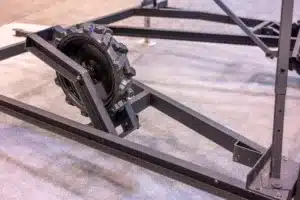No products in the cart.

365 Archery 3D Archery Targets
When folks enter a new industry, or even a new subsection of their industry, they usually dip their toe in by offering one or two



Minimum Illumination –
It is no secret, many game animals move in the cover of first and last light. Low light conditions are typically a nightmare for lower priced cameras to handle effectively. Your video will usually end up too dark to see anything, or with artifacting in the footage as the camera boosts the gain internally to try to “create” more light. Most camera manufacturers will list a minimum illumination number on the cameras spec sheet and these numbers will typically be listed in a term “lux”. The lower the lux number is, the better the camera will do in low light conditions. Pay particularly close attention as some manufacturers will list their minimum lux numbers in “low light mode” or when using another type of “high gain” mode. Typically you’ll want to find a camera with a minimum illumination rating of 3-4 lux or lower, preferably in auto mode. The primary camera I am currently using is the Canon XA10. The XA10 has a low light rating of 1.5 lux in auto mode and 0.1 lux in low light mode. A more affordable option with the same minimum illumination ratings would be the Canon Vixia HF G10.

Recording Media –
Gone are the days of recording to a physical tape type media. Almost all new HD cameras on the market record either to an internal hard disk drive, internal solid state hard drive, removable memory cards, or a combination of the above. We’d recommend you stay away from any spinning internal hard disk drive type cameras and purchase a camera with internal solid state memory or one that accepts removable memory cards. Make sure you purchase a fast memory card (or cards) from a reputable manufacturer (Sandisk, Kingston, Lexar, etc.). The ability to record to removable memory cards allows you to remove a memory card after you have finished recording, insert it into your computer’s memory card reader, and quickly access your videos without the need for additional cables. You’ll also be able to record hours upon hours of footage while only needing a couple of seconds to swap out the old memory card with a new one. This is especially helpful when you film footage throughout an entire season and don’t have time to connect your camera to a computer to download the footage after every day or couple of days to make room for your next hunt.

Microphone Inputs –
While the built-in microphones on cameras today have improved drastically, adding a shotgun microphone to your camera setup will enable you to capture much better audio for your hunts. Most cameras will have an unbalanced 3.5mm mini-jack microphone input while some high-end cameras now come with built-in balanced XLR audio inputs. I could go on and on about the differences between unbalanced (mini-jack type) and balanced (XLR type) microphones and which will result in better audio, but that discussion will have to wait for another day. You’ll also need to make sure the camera has an accessory shoe of some type to mount your microphone. If the camera you are looking for doesn’t have an accessory shoe or other way to mount a microphone, don’t sweat. There are several brackets on the market you can purchase to mount your microphone to your camera. You’ll also want a wind screen for your shotgun mic.

Remote Control Terminal –
The ability to turn on your camera, operate the zoom controls, and start/stop a recording external to your camera is a great feature to have when you are trying to SELFILM your hunts. On most cameras this input is called a LANC input, while on some of the Sony cameras you can control the camera through the AV/R input with the correct remote. This input will allow you to control all of the functions of your camera (pending the type of controller you buy) from one remote location.

I like to mount a LANC remote on the end of my fluid head handle for easy access and to reduce my hand movements to operate the camera. This will also allow for smooth zooming, and will also reduce unwanted camera noise from hitting the camera as you operate the zoom controls by hand.
Headphone Jack –
While this isn’t a make-or-break feature to have on your camera, it can be extremely helpful if you are serious about SELFILMing your hunts. A headphone jack will allow you to monitor your incoming audio and adjust the audio input levels depending on the environment you are filming in. You’ll also be able to detect if there are any undesirable hisses or cracks in your audio which could make your footage unusable if you don’t catch it in time. I’d consider this a “luxury” to have on a lower end camera and a must have on a more expensive camera.

Size –
When looking for a camera, you’ll also want to find something that is small and easy to carry around. As you’ll soon find out, when you start adding in filming equipment such as camera arms, tripods, etc. to your already necessary hunting equipment, the weight you’ll be carrying into the woods will start adding up quickly. Look for a camera that can be easily packed into your pack, and doesn’t require 6 months of uphill and downhill intense training to get into shape to carry to your stand.

Zoom –
One of the last features to consider before buying a primary camera is the cameras zoom ratio. Usually camera manufacturers will specify two separate zoom ratio numbers; an “optical zoom” and a “digital zoom”. We are only interested in the optical zoom as the digital zoom is actually the camera narrowing the field of view by enlarging the center portion of the image. By enlarging the center portion and cropping out the rest of the image, the quality of the image drops. For SELFILMing bow hunts, a 10x optical zoom is plenty for most situations. If you are looking to film out west over a great distance or if you are interested in filming rifle hunts, you’ll typically want to find something with a 20x optical zoom or greater.
We hope you found this information useful as you search for the right primary camera to fit your budget.
Want to stay up-to-date on what’s happening on the SELFILMED Blog and be the first to know about future giveaways and promotions? Make sure you enter your email address at top right to follow us and you’ll receive notifications by email the instant new articles are posted!

When folks enter a new industry, or even a new subsection of their industry, they usually dip their toe in by offering one or two

Highlights of Greylight’s new releases for 2024 – the Daybreak Blind, Transformer Tower, and Nomad trailer.

With one of their coolest decoys to date, the NWTF floor was buzzing with talk of the new DSD Preening Hen decoy. It’s almost TOO
Don’t miss a thing! Subscribe below to keep informed on everything that’s happening with the folks at SELFILMED.com